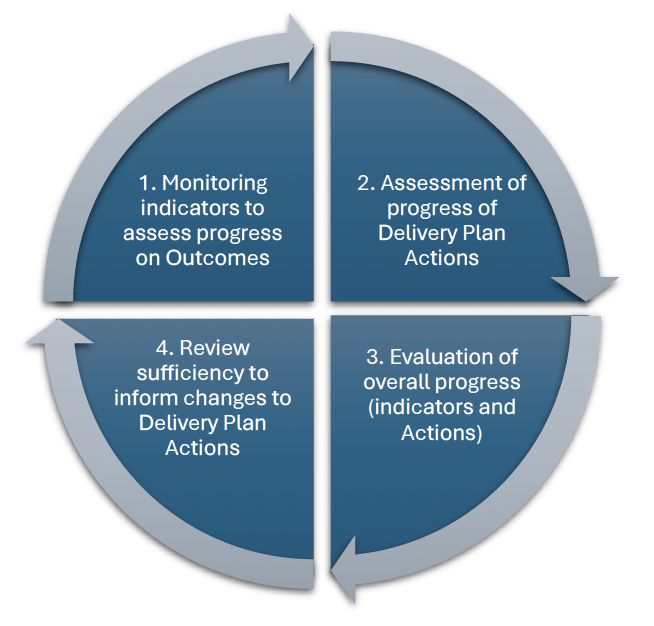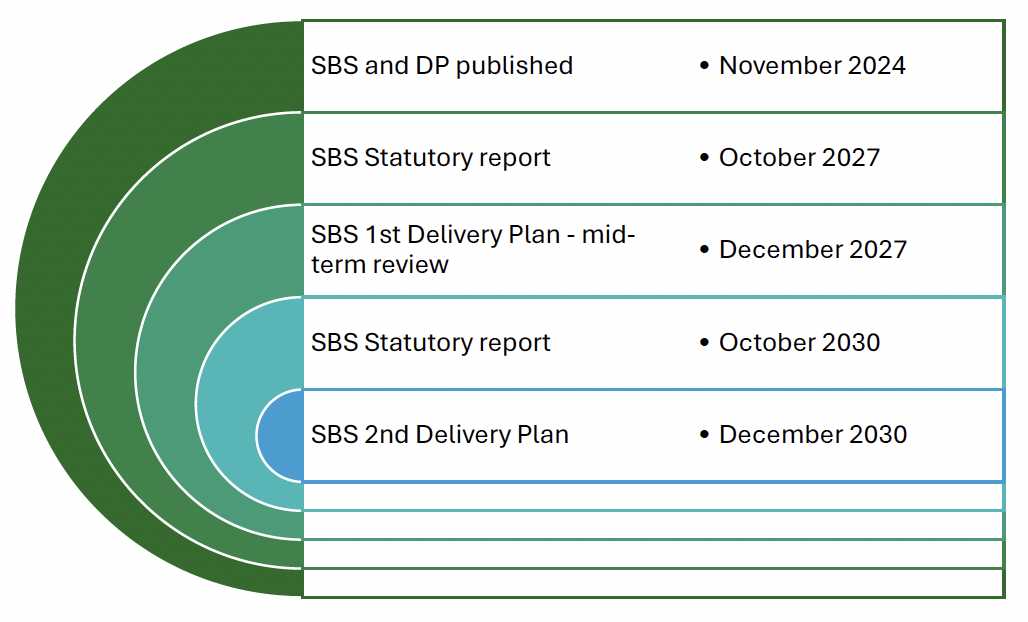Biodiversity strategy and delivery plan: governance, monitoring and evaluation
Sets out our approach to governance, monitoring and evaluation for Scotland's strategic framework for biodiversity, which includes the biodiversity strategy to 2045, delivery plan and statutory nature restoration targets.
Monitoring and Evaluation
Evidence-based conservation is at the heart of the Scottish Biodiversity Strategy. We need to monitor biodiversity at a local and a Scotland-wide level if we are to ensure our actions are effective in delivering our Vision and Outcomes. Both the methods used to monitor and the results of that monitoring must be transparent and publicly available.
Monitoring enables us to track progress, to demonstrate performance against targets, and informs regular review of our approach in response to changes, be they environmental (e.g. climate change), technological (e.g. improved techniques) or socio- economic (e.g. green finance).
New arrangements are being developed which will enable the Portfolio Board and the National Forum to assess:
a) Overall progress towards achieving the Outcomes in the Strategy
b) Whether the Actions in the Delivery Plan are being delivered
c) Whether additional or different Actions are required to achieve the high-level Objectives and / or Outcomes

Monitoring
Monitoring is essential if we are to evaluate progress of the SBS and meet our national and international commitments. There is a long-standing suite of biodiversity indicators that have been developed over a long period to monitor biodiversity in Scotland and have been used to track progress on the implementation of previous strategies. These indicators will be reviewed and aligned where appropriate to the Outcomes in the new strategy and reporting on them.
We already monitor the three strands of biodiversity identified in the Convention on Biological Diversity: ecosystems, species and genetic diversity and we will also monitor people’s attitudes to nature and the benefits they gain from it. Additional indicators will also be needed which reflect nature recovery at scale. Our suite of indicators will need to reveal how biodiversity is responding to pressures. Headline indicator changes alone can sometimes reflect the halting of biodiversity loss and subsequent recovery. However, natural conditions vary from year to year which can also have an impact and we will therefore need long-term data covering many species, habitats and influences to be clear on when and where loss has been halted, and real improvements have been made. We will also need to be able to drill down to individual species and habitats to focus conservation where it is most needed.
The Marine and Terrestrial Species Indicators will show changes across a suite of species. Species for which Scotland is internationally important require special monitoring efforts. These include oceanic lichens, bryophyte, seabirds, and species associated with seagrass and maerl beds. This will help us understand and act to protect these species. The Marine and Terrestrial Species Indicators will allow us to analyse data by habitat and to look in detail at groups like pollinators, thereby helping direct conservation effort where it is most needed.
Genetic diversity gives organisms the ability to adapt to new situations, such as climate change or novel pests and pathogens. Diversity within species, measured by the Genetic Diversity Scorecard, will show a decrease in the threats faced by native species. This will be the result of both better habitat connectivity and targeted efforts such as Gene Conservation Units.
Indicators will be required which demonstrate that the extent of land and sea under protected areas and Other Effective Area-based Conservation Measures (OECMs), and the condition of protected and managed features are increasing to at least meet the global target of 30% of land and sea protected. Key habitats – wetlands, woodlands, grasslands, rivers and lakes, upland and lowland heaths and scrub, rocky habitats, estuaries and lagoons, and dunes and many marine features - will have improved in condition and increased in extent. Across catchments, there will be greater connectivity between heath, woodlands, marsh and grassland habitats to sustain large-scale nature restoration.
By taking this rounded approach covering the core strands of biodiversity, we will be using the best available information to help us halt and then reverse biodiversity loss.
In addition we will monitor delivery of the actions in the Delivery Plan. The SBS Delivery Plan lists 163 actions, of which 31 are classed as “priority actions”. Regular monitoring and evaluation of the progress of each of these actions on a more frequent basis than the SBS statutory reporting is important to maintain focus and ensure effective management.
Evaluation
A 4 step evaluation process is being developed which
- analyses biodiversity monitoring data (Step 1) to provide an assessment of biodiversity in Scotland; and
- assesses the status of actions in the delivery plan (Step 2)
to support an overarching assessment of the impact our actions are having, and decision making to ensure we are able to adapt in the light of information about our success in addressing biodiversity loss and delivering nature restoration. (Steps 3 and 4).

Reporting cycles
Biodiversity can often respond only very slowly to change, so it is important to ensure that reporting cycles are meaningful and would inform the planned 6 yearly delivery plans.
The Nature Conservation Act 2004 establishes a statutory duty to report on the implementation of the strategy every 3 years. The Biodiversity Portfolio board will be provided with a report on progress on delivering the actions in the delivery plan every quarter (dashboard style) . On an annual basis the board will report to the subcommittee on climate change and the National Stakeholder Forum on progress to delivering actions. Every 3 years, taking into account the data from the SBS 3 year reports alongside the delivery plan assessments the portfolio board will make recommendations for a mid-term review of the actions in the current plan. Every 6 years the portfolio board will take into account the SBS 3 year report and delivery plan assessments and which inform the next 6 year delivery.

Independent Review Body
Statutory nature restoration targets are a key element of the Strategic Framework. Given the complexity of nature restoration, interpreting relevant data can be challenging. The possibility of multiple and competing narratives emerging, potentially creating a confused discourse around progress to meet targets needs to be managed. It is proposed that an Independent Review Body (IRB) will be designated. This will provide objective clarity to this complexity, and accountability on Scottish Ministers’ work to meet the targets.
The complexity of nature restoration also means that while the best Scottish scientific data and analysis is being used to set targets that are credible and achievable, there are scenarios that would require targets to be reviewed and amended. For example: there is a high degree of uncertainty around how climate change will impact efforts to restore nature; new scientific evidence may suggest targets need to be amended to drive more effective action; and new technology will provide better means of measuring our progress. An effective framework for targets must therefore be sufficiently agile to respond to these and other uncertainties. However, it must do so in a manner that ensures confidence in the ambition to deliver the Strategic ambition which targets are designed to achieve. The proposed IRB will therefore have a key oversight role, providing objective scrutiny to any proposal to amend targets.
Contact
Email: biodiversity@gov.scot
There is a problem
Thanks for your feedback